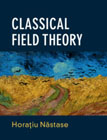
Classical field theory predicts how physical fields interact with matter, and is a logical precursor to quantum field theory. This introduction focuses purely on modern classical field theory, helping graduates and researchers build an understanding of classical field theory methods before embarking on future studies in quantum field theory. It describes various classical methods for fields with negligible quantum effects, for instance electromagnetism and gravitational fields. It focuses on solutions that take advantage of classical field theory methods as opposed to applications or geometric properties. Other fields covered includes fermionic fields, scalar fields and Chern–Simons fields. Methods such as symmetries, global and local methods, Noether theorem and energy momentum tensor are also discussed, as well as important solutions of the classical equations, in particular soliton solutions. INDICE: Preface; Introduction; 1. Short review of classical mechanics; 2. Symmetries, groups and Lie algebras. Representations; 3. Examples: the rotation group and SU(2); 4. Review of special relativity. Lorentz tensors; 5. Lagrangeans and the notion of field; electromagnetism as a field theory; 6. Scalar field theory, origins and applications; 7. Nonrelativistic examples; water waves, surface growth; 8. Classical integrability. Continuum limit of discrete, lattice and spin systems; 9. Poisson brackets for field theory and equations of motion. Applications; 10. Classical perturbation theory and formal solutions to the equations of motion; 11. Representations of the Lorentz group; 12. Statistics, symmetry, and the spin-statistics theorem; 13. Electromagnetism and the Maxwell equation; Abelian vector fields; Proca field; 14. The energy-momentum tensor; 15. Motion of charged particles and electromagnetic waves; Maxwell duality; 16. The Hopfion solution and the Hopf map; 17. Complex scalar field and electric current. Gauging a global symmetry; 18. The Noether theorem and applications; 19. Nonrelativistic and relativistic fluid dynamics. Fluid vortices and knots; 20. Kink solutions in ø4 and sine-Gordon, domain walls and topology; 21. The Skyrmion scalar field solution and topology; 22. Field theory solitons for condensed matter: the XY and rotor model, spins, superconductivity and the KT transition; 23. Radiation of a classical scalar field. The Heisenberg model; 24. Derrick's theorem, Bogomolnyi bound, the Abelian–Higgs system and symmetry breaking; 25. The Nielsen–Olesen vortex, topology and applications; 26. Nonabelian gauge theory and the Yang–Mills equation; 27. The Dirac monopole and Dirac quantization; 28. The 't Hooft–Polyakov monopole solution and topology; 29. The BPST-'t Hooft instanton solution and topology; 30. General topology and reduction on an ansatz; 31. Other soliton types. Nontopological solitons: Q-balls; unstable solitons: sphalerons; 32. Moduli space; soliton scattering in moduli space approximation; collective coordinates; 33. Chern–Simons terms: emergent gauge fields, the Quantum Hall Effect (integer and fractional), anyonic statistics; 34. Chern–Simons and self-duality in odd dimensions, its duality to topologically massive theory and dualities in general; 35. Particle-vortex duality in 3 dimensions, particle-string duality in 4 dimensions, and p-form fields in 4 dimensions; 36. Fermions and Dirac spinors; 37. The Dirac equation at its solutions; 38. General relativity: metric and general coordinate invariance; 39. The Einstein action and the Einstein equation; 40. Perturbative gravity: Fierz–Pauli action, de Donder gauge and other gauges, gravitational waves; 41. Nonperturbative gravity: the vacuum Schwarzschild solution; 42. Deflection of light by the Sun and comparison with general relativity; 43. Fully linear gravity: parallel plane (pp) waves and gravitational shockwave solutions; 44. Dimensional reduction: the domain wall, cosmic string and BTZ black hole solutions; 45. Time dependent gravity: the Friedmann–Lemaitre–Robertson–Walker (FLRW) cosmological solution; 46. Vielbein-spin connection formulation of general relativity and gravitational instantons; References; Index.
- ISBN: 978-1-108-47701-7
- Editorial: Cambridge University Press
- Encuadernacion: Cartoné
- Páginas: 480
- Fecha Publicación: 14/03/2019
- Nº Volúmenes: 1
- Idioma: Inglés
